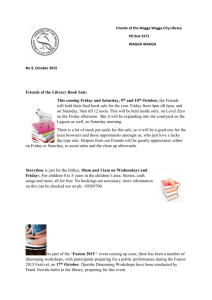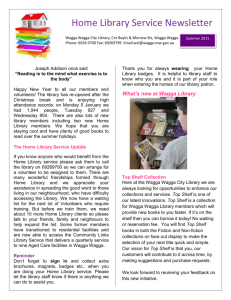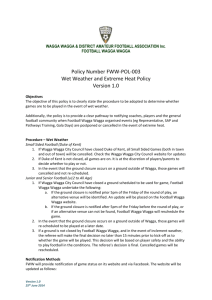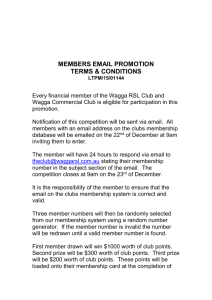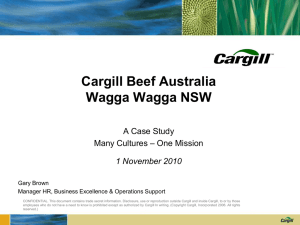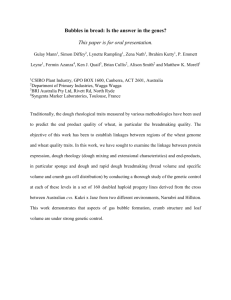Wagga Wagga Livestock... - Charles Sturt University
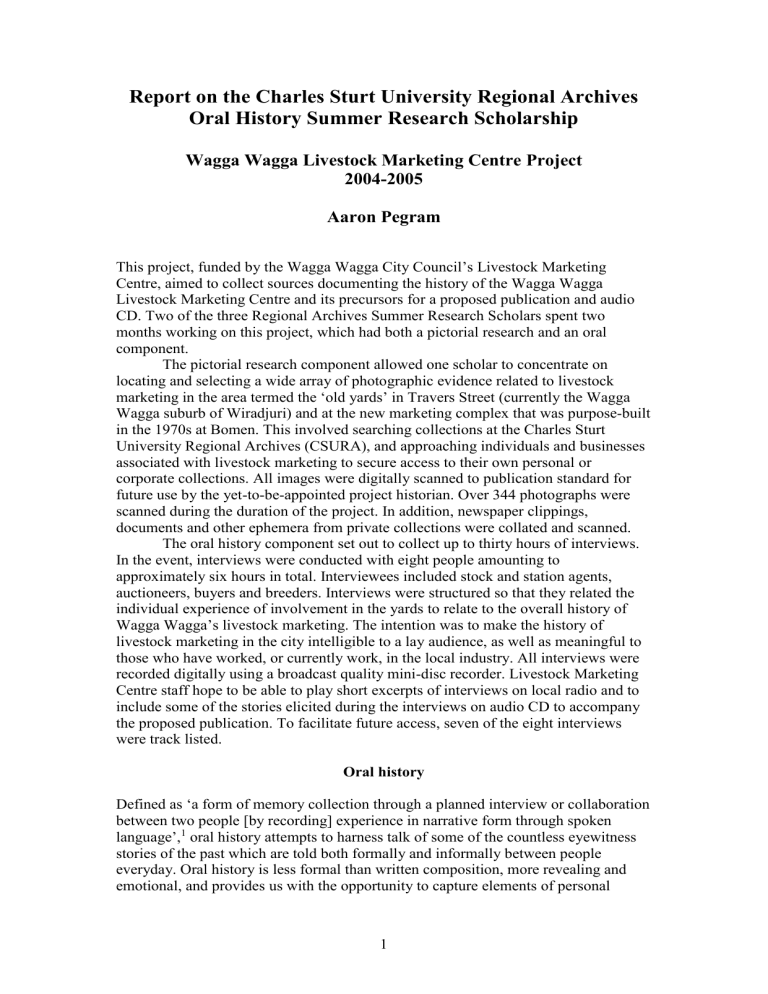
Report on the Charles Sturt University Regional Archives
Oral History Summer Research Scholarship
Wagga Wagga Livestock Marketing Centre Project
2004-2005
Aaron Pegram
This project, funded by the Wagga Wagga City Council’s Livestock Marketing
Centre, aimed to collect sources documenting the history of the Wagga Wagga
Livestock Marketing Centre and its precursors for a proposed publication and audio
CD. Two of the three Regional Archives Summer Research Scholars spent two months working on this project, which had both a pictorial research and an oral component.
The pictorial research component allowed one scholar to concentrate on locating and selecting a wide array of photographic evidence related to livestock marketing in the area termed the ‘old yards’ in Travers Street (currently the Wagga
Wagga suburb of Wiradjuri) and at the new marketing complex that was purpose-built in the 1970s at Bomen. This involved searching collections at the Charles Sturt
University Regional Archives (CSURA), and approaching individuals and businesses associated with livestock marketing to secure access to their own personal or corporate collections. All images were digitally scanned to publication standard for future use by the yet-to-be-appointed project historian. Over 344 photographs were scanned during the duration of the project. In addition, newspaper clippings, documents and other ephemera from private collections were collated and scanned.
The oral history component set out to collect up to thirty hours of interviews.
In the event, interviews were conducted with eight people amounting to approximately six hours in total. Interviewees included stock and station agents, auctioneers, buyers and breeders. Interviews were structured so that they related the individual experience of involvement in the yards to relate to the overall history of
Wagga Wagga’s livestock marketing. The intention was to make the history of livestock marketing in the city intelligible to a lay audience, as well as meaningful to those who have worked, or currently work, in the local industry. All interviews were recorded digitally using a broadcast quality mini-disc recorder. Livestock Marketing
Centre staff hope to be able to play short excerpts of interviews on local radio and to include some of the stories elicited during the interviews on audio CD to accompany the proposed publication. To facilitate future access, seven of the eight interviews were track listed.
Oral history
Defined as ‘a form of memory collection through a planned interview or collaboration between two people [by recording] experience in narrative form through spoken language’, 1
oral history attempts to harness talk of some of the countless eyewitness stories of the past which are told both formally and informally between people everyday. Oral history is less formal than written composition, more revealing and emotional, and provides us with the opportunity to capture elements of personal
1
experience that have previously been either taken for granted or have been neglected by other sources. The ABC’s Voices of the Bush , for example, is an audio publication of a series of oral history interviews with Australians living and working in the bush, including drovers and shearers, conservationists, foresters and farmers who tell something of the social history of isolation in rural areas.
2
Amongst the oral history recordings from the Voices of the Bush series (held at the National Library of
Australia) is an interview with Italian migrant Norina Pastro, a retired caterer from
Griffith, who speaks about why her family migrated to Australia, her earliest memories of Australia, the Great Depression, the Second World War, family living conditions and Italian marriage customs.
3
Oral history therefore offers us the chance to recapture the experiences that primary sources have failed to capture, and record those that have shaped people’s lives by seizing the feelings and emotions attached to periods or events, and allowing historians literally to question the past rather than seek to understand and interpret the existing material.
In capturing these undocumented personal stories, oral history embraces individual reflection and hindsight that has been generated at a later stage in life.
Unlike ‘static’ historical sources such as newspapers, diaries and other documents that are ‘fixed’ in the past, oral history’s dependency on memory gives it a ‘fluid’ character, as the use of retrospection allows for a variety of influences to operate. The role of hindsight in oral history is neatly illustrated in the interview with stock and station agent Geoff Francis, as he reflects on the transition of Wagga Wagga’s livestock marketing from the pen selling in the ‘old yards’ in Travers Street, to the technologically advanced ring selling system at Bomen in 1979:
…a lot of the ‘cockies’ and a lot of the buyers didn’t want ring selling; they wanted the old system of selling in the pen. I was against it at the time too, but we knew we had to make it work and now it does work…I think now that its nice to sit in the ring with the air conditioning, or on a stinking wet day, sitting up there without oilskins on getting wet trying to book… 4
Because of its dependency on memory, and the use of retrospection, there is some scope to question oral history’s reliability. The human memory is prone to forget or misinterpret, is vulnerable to fabrication, and can be altered with the passage of time. More consciously, memories can be selected and edited, there may be some incentive either to ‘over egg’ or downplay memories, and the reputation of the self or others may be at stake. For these reasons it is wise to regard oral history as a secondary source, or alternatively to consider it as a contemporary reflection on past events. Oral history’s strength, like most secondary sources, is when it is corroborated with existing ‘fixed’ (primary) sources such as council minutes and photographs.
Reflections on the oral history project
In total, eight interviews were held with members of the Wagga Wagga livestock marketing community, which amounted to approximately six hours of recorded information. Although the project had aimed to collect up to thirty hours of recorded interviews, issues of timing (the Christmas/New Year holidays), and the willingness of potential interviewees to take part affected the outcome.
Despite a lot of enthusiasm for the project in the livestock marketing community, there were few who were keen to make the time to sit down for an interview. This was variously explained. Some insiders pointed to the tight deadlines under which people in the industry operate, the considerable distances they travel, and
2
the margins on which they operate. The interviewer wondered whether his status as a layman or outsider was a further complication. Although the project received newspaper and television coverage (the newspaper producing the majority of contacts not already made through personal networking), it would have been beneficial for this publicity to have occurred earlier.
If further interviews are to be conducted for this project, it might be worth while to have an interviewer who is both familiar with the interviewees and with livestock marketing. In the relatively short-time frames which most interviewees appeared to want to devote to the project, there was little time to put them at their ease. They probably would be more comfortable with someone they knew and who they recognised as familiar with their industry.
A glance of the occupations of the recorded interviewees reveals a bias towards Wagga Wagga’s stock and station agents. Of the eight interviews that were held, four were with stock and station agents, three of them actively engaged in business, and one in retirement. Absent from the sample of interviewees were farmers, drovers, transporters and non-professional buyers who were either too busy to take part in the two-month project (as in the case of the local transporters), or considered that their experiences were not important enough for the historical record.
Again, someone with knowledge of the industry and firm local connections might be better placed to achieve positive results.
Because most of the interviewees are still engaged in local livestock marketing, it was interesting to note their selectivity and self-censorship as they related choice anecdotes, suggesting the extent to which personal and business reputations are at stake. Although now retired, professional buyer Bill Cheshire consciously ‘mouthed’ (but did not utter) the name of a local stock and station agent who had arranged to give him a lift to a cattle sale in Ungarie, only to leave him stranded in Wagga Wagga.
5
Storytelling has played a central role in the oral history project: an outcome that was confidently anticipated by the Executive Officer of the Livestock Marketing
Centre. Stories as far back as the 1920s were elicited in the interviews. Although these stories can give us an indication of the personalities that dominated the saleyards during these times, it is certain that portions of these well-polished anecdotes are either emphasised or downplayed to put the narrator (or his business) in a more positive light. For example, following Bill Cheshire’s abandonment in Wagga Wagga by a local stock and station agent, he opts to take to the air in a Tigermoth bi-plane
(minus his goggles mind you), and arrive in Ungarie in style: ‘I’ve made [it] here you bastards, haven’t I ?’
6
Similarly, Keith Le Lievre was keen to emphasise his first meagre wage of £0/32/6 a week, in a job which he considered to be ‘…a rough education for a 16 year old’.
7
(Le Lievre proved the most historically conscious interviewee, which is perhaps not surprisingly in view of his long association with the
Wagga Wagga and District Historical Society.) Despite poetic license in some of the stories, they are indeed important to the history of Wagga Wagga’s livestock marketing, as storytelling has undoubtedly been an integral part of the industry experience.
Biographies of interviewees
Short biographies of the eight individuals who were interviewed for the project follow:
3
Bernie Noonan
Born in Seymour (Victoria) in the 1930s, Bernie began his working life as a butcher boy for Mick Moylan after his schooling in Shepparton. In January 1950 he joined
Frank Watson & Co., stock and station agents, who were agents for Australian
Mercantile Land and Farming (AML&F), which subsequently took them over. After working in Shepparton for approximately five years, Bernie was transferred by
AML&F to Tatura. He married in Shepparton, and had another transfer, this time to
Bairnsdale in predominantly cattle country of the Gippsland Region, where he spent the next five years as a livestock auctioneer. In 1961, Bernie moved to Wagga Wagga as an auctioneer for AML&F. The firm was eventually taken over by Elders. Bernie has been in Wagga Wagga for the last 45 years, and is still operating as a livestock auctioneer for Noonan & Co.
Mick Noonan
Son of Bernie Noonan, Mick Noonan was born in Bairnsdale in Victoria in 1958 and was schooled entirely in Wagga Wagga at St Michael’s and at Trinity Senior High
Schools). When his father was an auctioneer for AML&F, Mick remembers helping out in the ‘old yards’ from the age of seven during his school holidays: firstly by
‘being a nuisance’, then gradually helping Mick Keef unloading trucks and delivering lambs. Mick ‘got the bug of being a stock and station agent’ with Elders Wool
Company. He left Wagga Wagga to work for Elders in 1975, and learned not only the auctioneering side of livestock marketing, but was well educated in all facets of the industry including accounting, insurance and finance. After working in Cootamundra,
Young, Ivanhoe, Condobolin, Walgett, Bourke, Bathurst, and Forbes as a Branch
Manager, Mick eventually returned to the area by working in Junee and gradually the new Wagga Wagga livestock marketing centre at Bomen. Mick works for Noonan &
Co. as an auctioneer.
Keith Le Lievre
As a 16 year old during the 1940s, Keith worked on his family’s property after the death of his father. Keith’s sister worked for Dalgety’s in Wagga Wagga and managed to obtain employment for him because the Second World War had reduced staff numbers considerably. Keith considers he was ‘thrown in at the deep end’ as he had no formal training with Dalgety’s and was immediately dispatched to the Wagga
Wagga saleyards as an auctioneer. After spending a short period at The Rock and at
Holbrook, he returned to Wagga Wagga where he continued in management with
Dalgety’s until his retirement in 1985.
Bill Cheshire
Bill was born in the Saleyards Inspector’s hut in the corner of the AML&F resting paddock at the Tarcutta St Saleyards in the late 1920s, and spent most of his childhood at the Saleyards as his father was the Saleyards Inspector from the early
1920s to the 1950s. Bill began employment with AML&F as a 14 year old schoolboy, but was forced to complete his schooling. He returned to AML&F for just three weeks of full-time employment, then began working part-time for Sid Best in Wagga Wagga as a transporter at the pig sales. He filled in his time with droving and trucking around the yards until he began working for R.A. Napp Pty Ltd as a sheep, cattle, bull, pig and horse buyer. He worked for Napps for 18 years. When the company was taken over by Tancred Bros from Sydney, Bill became a commission buyer until he retired in 1993.
4
Kevin Hogg
After leaving school in Moree in the late 1960s, Kevin was recruited by agents of A.J.
Bush & Sons Meat Company in 1970. He was paid $12 per week by Bush & Sons and was required to undertake studies at Yanco Agricultural College. While being employed full-time as a professional sheep buyer, Kevin attended most sales in the
Riverina including Wagga Wagga and Coolamon. He worked for Bush & Sons for eight years before being offered a job in Cootamundra with Conkey & Sons. He worked for them for four years, and for a further four years with Metro Meats (which had bought out Conkey & Sons). Following his return to Coolamon, Kevin worked for Bush & Sons as a commission buyer. He currently runs his own Meat Company.
Geoff Francis
After leaving school in 1952, Geoff began employment with Younghusbands & Co. as a junior auctioneer on a three month contract, whilst another employee was undertaking national service training. He remained at Younghusbands for ten years.
Having experienced farming life on his uncles’ properties at Lockhart, Francis considered his employment as a natural progression. In 1961, he and his brothers
Harry and Ian opened up their own stock and station agency, H. Francis & Co, where he is still working.
Laurie Hull
Originally a wool classer, Laurie Hull became a livestock marketing reporter whilst working for the Agricultural Department at Wagga Wagga in 1976. Starting out reporting sales from the ‘old yards’ on local radio, Hull continued to report once local livestock marketing moved to the newly established Bomen complex. He retired in
1994.
Jim Daley
Jim was originally a sheep and wool instructor with the Department of Agriculture at
Wagga Wagga. After the Second World War, he established his own business as a stud adviser.
1 Hamilton, P. (1998) ‘Oral History’ in The Oxford Companion to Australian History , G. Davidson,
J.Hirst & S. Macintyre (eds), Oxford University Press, Melbourne, pg.481.
2 Ross, J. (2001) Voices of the Bush: Country Australia on ABC Radio , ABC Books for the Australian
Broadcasting Corporation, Sydney.
3 NLA, ORAL TRC 4572/57-58
4 Oral history interview with Geoff Francis, 18/01/2005.
5 Oral history interview with Bill Cheshire, 01/02/2005.
6 Ibid.
7 Livestock Marketing History and typescript memoirs, Keith Le Lievre papers.
5

